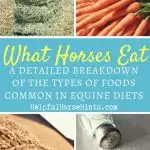While many people may think that a horse’s diet is pretty simple, it is actually far more complex than most people realize. Horses must maintain a balanced diet so that they stay happy and healthy. But what do horses eat and how much should you feed your horse? The goal of this article is to help answer that!
Horses eat a variety of foods including hay, grass, grains, and minerals. Every horse’s diet should be tailored to fit their specific needs. It is important to stick to a regular feeding schedule to avoid digestive issues. There are also some foods out there that you should never feed your horse.
All horse owners should know the ins and outs of feeding their horses an appropriate diet. Domestic horses depend entirely on their owners for their food and in order to take care of them properly, you need to know all the facts.
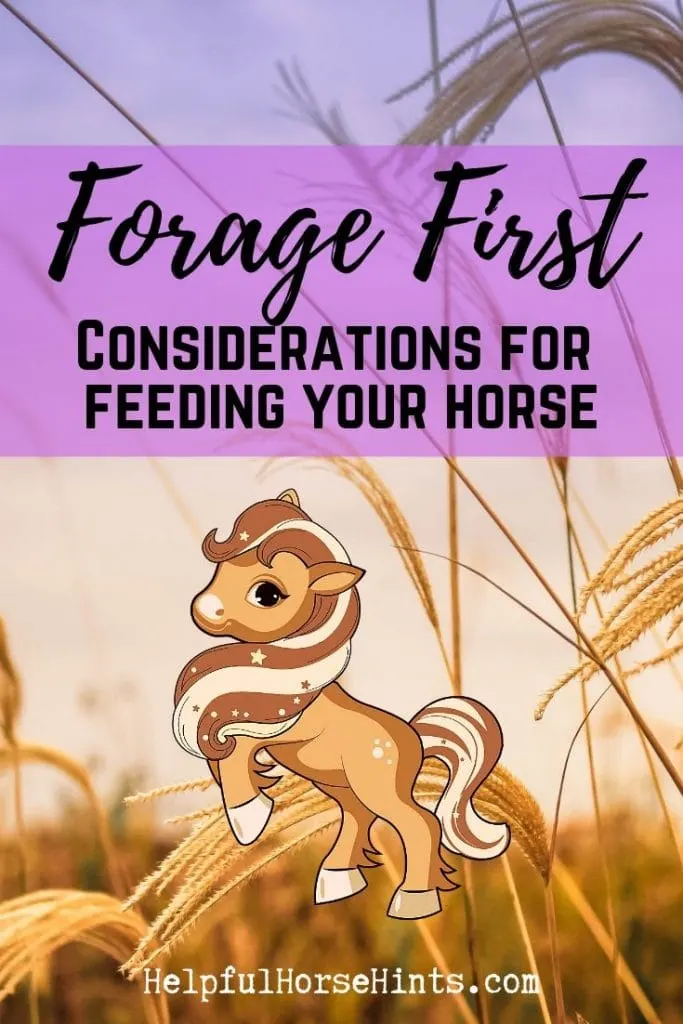
Table of Contents
Types of Feed
Forage (Hay vs Pasture)
Horses need to eat a source of forage on a daily basis. Forage is a natural roughage that helps their digestive system function properly.
Forage comes in many different forms, the most common of which is hay and pasture. Hay is essentially grass that has been dried and baled for storage. Pasture is fresh grass available for a horse to eat at whim.
The choice to use hay or pasture really depends on the living arrangement for the horse. In the city or suburbs, access to pastures large enough to feed a single horse, let alone a herd of them, isn’t usually available. In that case, horses are boarded in smaller stalls and fed hay in some form or another.
Pasture, on the other hand, is typically widely available in the midwest and eastern states. These also tend to be areas with a lot of wide-open space where a horse owner is more likely to be able to grow enough high-quality grass to feed a whole herd of horses.
Pasture grass is the most nutritious forage for a horse. New, fresh grass has the highest levels of protein and a huge amount of vitamins. As the grass grows higher, the protein levels start to drop.
Once the grass is high enough to cut and dry to make hay, the protein count has lowered significantly. After it is cut, the amount of vitamins in hay also drops.
Hay is the best substitute for pasture grass because it contains a similar albeit lowered nutritional value. The trick with hay is to make sure that the quality is high and that it has been stored properly.
Hay must be covered and kept dry during storage. You should never feed moldy hay, hay that has gotten wet, to a horse. A high-quality hay will help your horse maintain its weight and body composition when grass is scarce or unavailable.
According to the Merck Veterinary Manual horses should eat close to 2 percent of their body weight in forage each day. That means a 1,000 pound horse should be eating about 20 pounds of grass or hay each day.
You can add grains, however, you always have to keep forage in their diets regardless of whether you feed grain or not.
Salt
In addition to pasture, salt is another must-have. Horses need salt in their diets because it is absent from hay and grass.
Salt helps regulate your horse’s intake of water and it is essential for their bodies. The great thing about salt is that most horses will self intake salt when needed if they are provided access to a salt block. In fact, it is common to ensure each horse and each pasture has a dedicated source of salt.
You can add loose salt to their grain, but the easiest method is the salt block or free choice minerals placed in a separate tub. Horses will actively seek out salt if they need it and will only consume what they need.
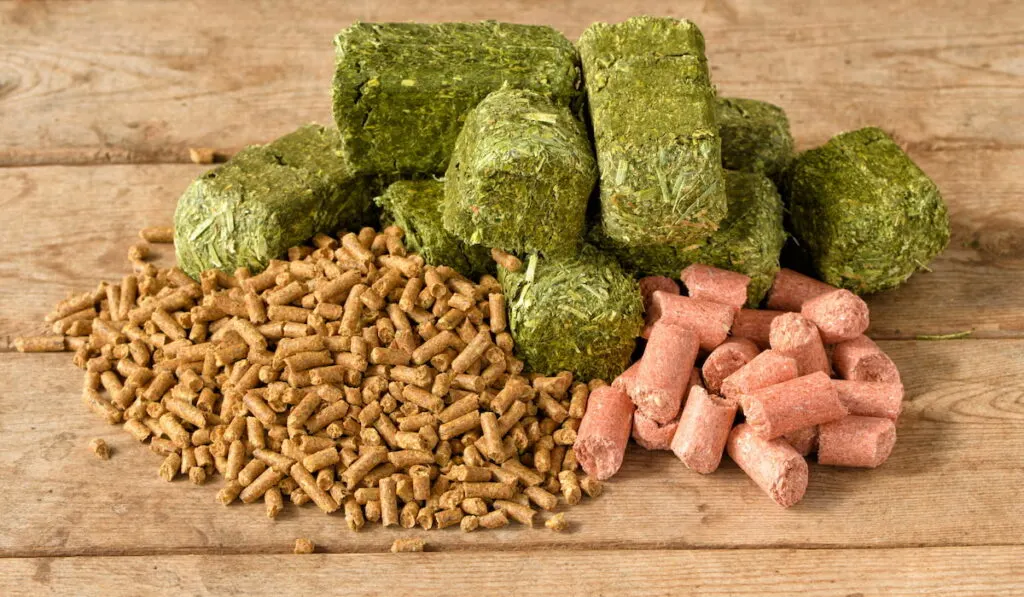
Vitamins and Minerals
Most horses do not get adequate amounts of vitamins and minerals from their grains alone. Even if they eat grass, some areas may lack specific vitamins and minerals that are essential for a horse’s health.
If your horse is only eating hay, they more than likely will need a vitamin and/or mineral supplement to help meet their nutritional needs. The type of supplements needed will vary depending on the nutrient levels in the feed.
Forage testing is commonly used to test the nutrition value of baled hay. You may want to check with your hay dealer to see if a forage analysis has been performed. If not, there are companies that will do it for you for a small fee.
Vitamin E is usually found in high quantities in grass, but if your horse is not on pasture, they will need a vitamin supplement to make up for this. You should work with your vet to find out what vitamins and minerals your horse is lacking in its current diet.
Selenium, when combined with Vitamin A, is thought to help prevent nutritional muscular dystrophy in horses.
Selenium is considered a macromineral and naturally occurs in soil however, the concentration levels in most of the United States are not adequate enough to meet a horse’s nutritional needs. (source)
When this is the case, both Vitamin E and Selenium can be obtained commercially and fed with grain or other concentrated ration as a supplement.
Keep in mind that this is not a comprehensive list of teh vitamins and minerals required by horses. Calcium, Phosphorus and even Magnesium are important as well. There are a large number of vitamin and mineral supplements out there that can easily be added to your feeding program.
Grains/Concentrates
Many horse owners add grain to their horse’s diet for a variety of reasons. If they do not have sufficient pasture available, they may need to add grain to help supplement their hay. There are many factors you should take into account when choosing a grain or concentrated feed for your horse.
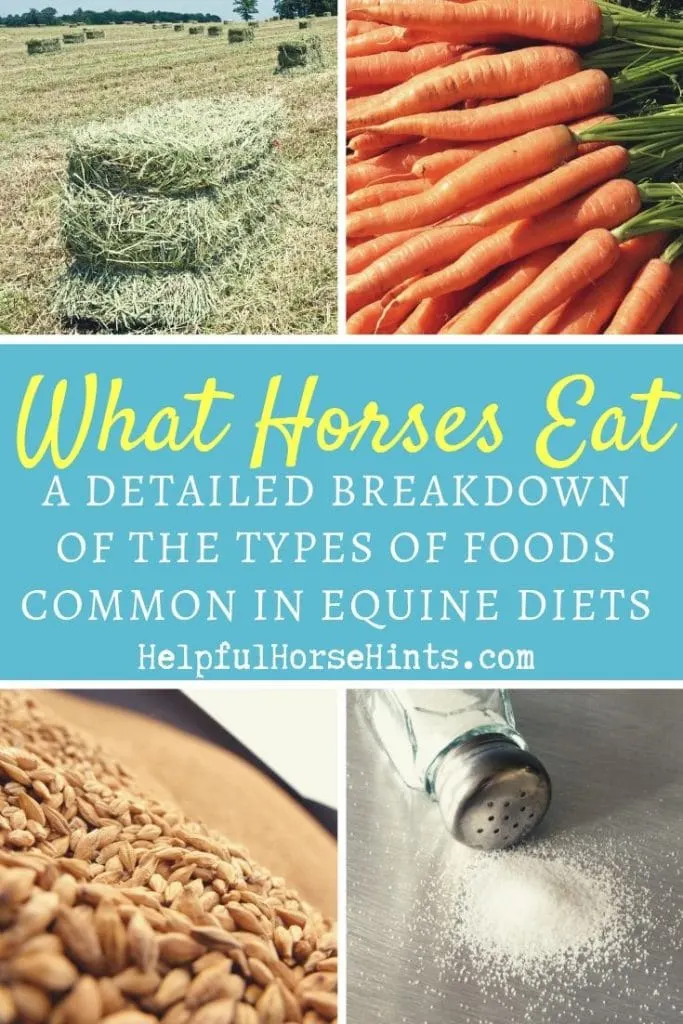
Feed Type
Naturally occurring grains like oats and barley can be attained whole, processed (like rolled oats) or included in mixed grains like sweet feeds and pelleted feeds.
Sweet feeds and pelleted feeds are the most common types of mixed grain fed to horses. Sweet textured feeds typically contain a mixture of oats, corns and molasses. Keep in mind that this added sugar content can cause hyperactivity in horses.
There are different types of grains that you can feed your horse, but whichever one you choose, be sure to keep feeding it. Switching grains abruptly can cause digestive issues in your horse. Once you find a feed that works for your horse, stick with it.
Horse Specific Feeds
When choosing a grain to feed your horse, always make sure it is marketed specifically for horses. There are some grain feeds out there that are marketed as ‘all-stock’ feed for all varieties of farm animals. These may not be safe to feed to your horse.
A horse’s digestive system functions a lot differently from that of cows and goats. It is not recommended to feed horses an all-stock feed because it does not contain a proper balance of ingredients for a horse’s specific nutritional needs.
Formulated Feeds
Another thing to consider when picking out a grain is your horse’s age. Certain horse feeds are tailor-made for horses based on their stage of development.
Senior feeds are designed specifically for the needs of an older horse. If your horse suffers from any medical issues, be sure to look for grains designed especially for their condition.
Likewise, mare and foal feeds are specially formulated to meet the higher energy needs of broodmares and their babies.
Grain companies really do have your horse’s best interests at heart. They work with equine nutritionists to develop a ration that will work for the majority of the equine population.
Local grain companies may even be able to develop custom grain or ration balancer feeds that take into account the protein, vitamin and mineral levels available on locally grown hay. This can be a big plus as it ensures your horse’s ration is more closely matched based on the forage he eats.
Treats
Feeding your horse treats is a great way to reward good behaviors. Luckily, most horses love treats that are good for them.
Fruits such as apples, bananas, and watermelon are great choices to feed as treats. Most horses enjoy vegetables such as carrots, celery and sweet potatoes. In fact, I made an article showcasing 15 fruits and vegetables horses love to eat.
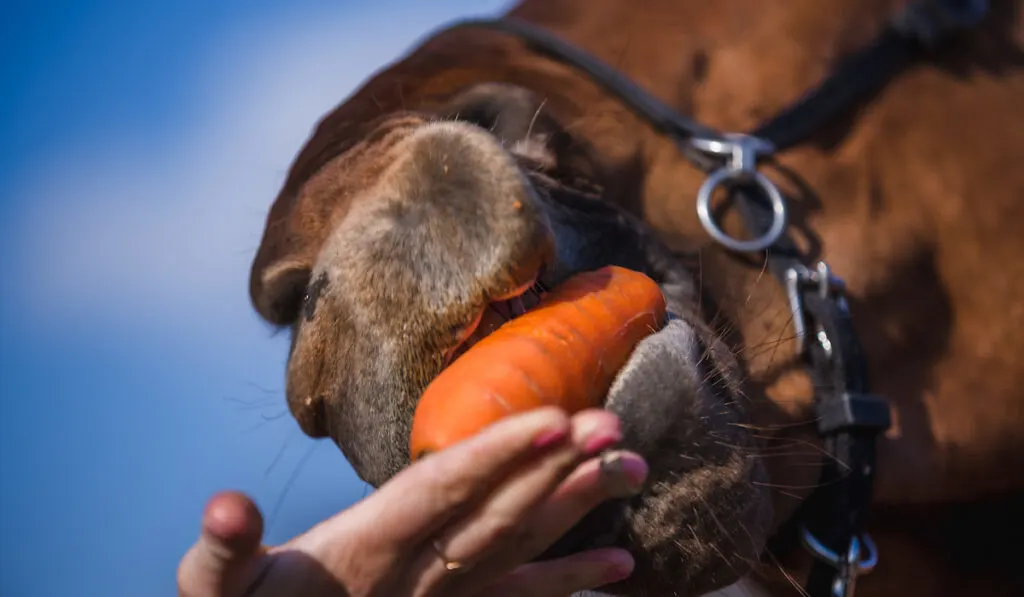
Keep in mind that, just like humans, some horses may have allergies or nutritional reasons where they shouldn’t be allowed certain treats.
Any treat should be fed to horses in moderation, however, to prevent stomach upset. Anything given suddenly to a horse in large quantities may cause them to colic.
Water and Why It Is Essential During Feeding
Horses need an adequate water supply on a daily basis. Water is essential for a horse’s digestive system, especially if they are eating dry feeds such as grain and hay.
Fresh, clean water should be supplied to horses at all times.
Some horses can be extremely picky and prefer pristinely clean water. Some will only drink out of certain buckets or be resistant to drinking when away from home.
Most horses need to drink around 6-10 gallons of water daily. If it is a particularly hot day, or they are working, they will need even more.
If your horse is not taking in as much water as necessary due to stress or anything else, you can often times try adding water to their feed. This can be accomplished by soaking hay or making wet, sloppy grain mashes instead of feeding grain dry.
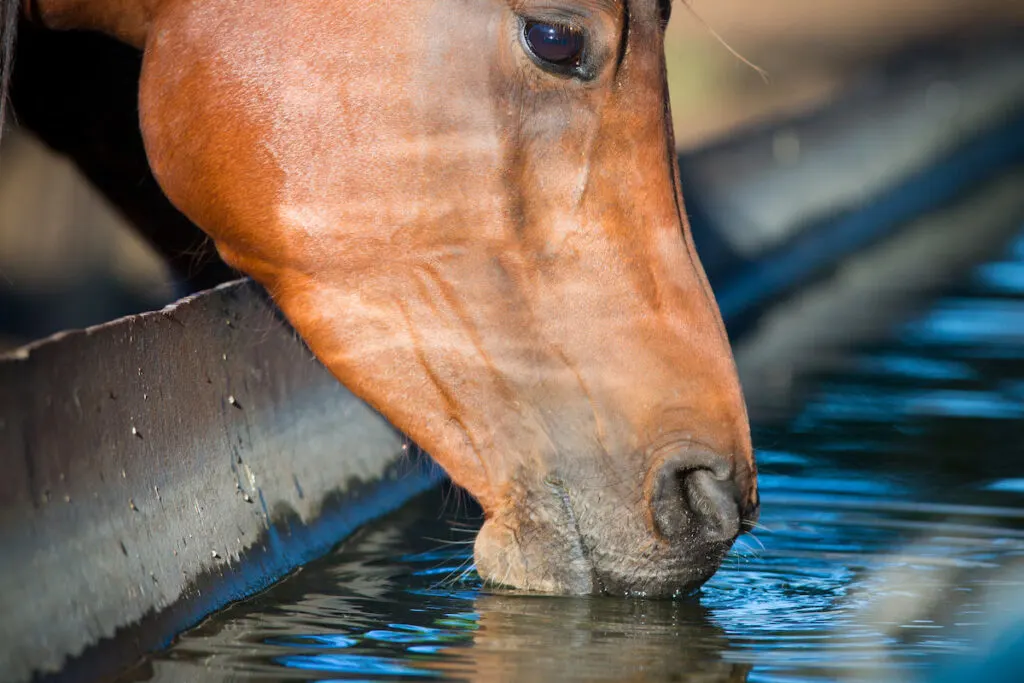
How Often to Feed Your Horse
If horses are left out on a lush pasture, they can graze whenever they want. However, if they are stalled or confined most of the day, they should be fed multiple small meals per day.
Some people feed twice a day and some choose to feed 3 times a day. As I covered in this article, you could even feed your horse only once per day if necessary.
You will have to decide what works best for your situation. A horse has a relatively small stomach compared to how large their bodies are. The best option is for each feeding to last multiple hours or to feed the horse in small increments multiple times a day.
By feeding multiple small meals a day, you give them time to properly digest their food. Small meals also mimic their natural eating habits.
How Much to Feed Your Horse
Remember, horses need to eat about 2% of their weight in hay or grass each day. If you are feeding grains, make sure that you still provide them with forage at every meal.
If you are just deciding to add grains to their diet, start off by following the feeding recommendations on the bag of grain you decide to feed but be sure to introduce new feeds gradually over a period of days.
You should work with your veterinarian to adjust the ration according to your specific horse’s needs. A lower-cost alternative to a veterinary consultation is to contact your favorite grain manufacturer and see if they have a nutritionist on staff that can provide you with, an often free, consultation.
Every horse should be fed, at a minimum:
- 2% of their body weight daily in forage.
- Unlimited access to water and salt.
- Vitamin and mineral supplements necessary for your area / forage type
Keep in mind that this list above did not include grain. Grains and concentrates are not a necessary element for every horse. They are an excellent source of energy, nutrition, and vitamins for horses that need it but some horses, like those in low work, may not need them at all. (source)
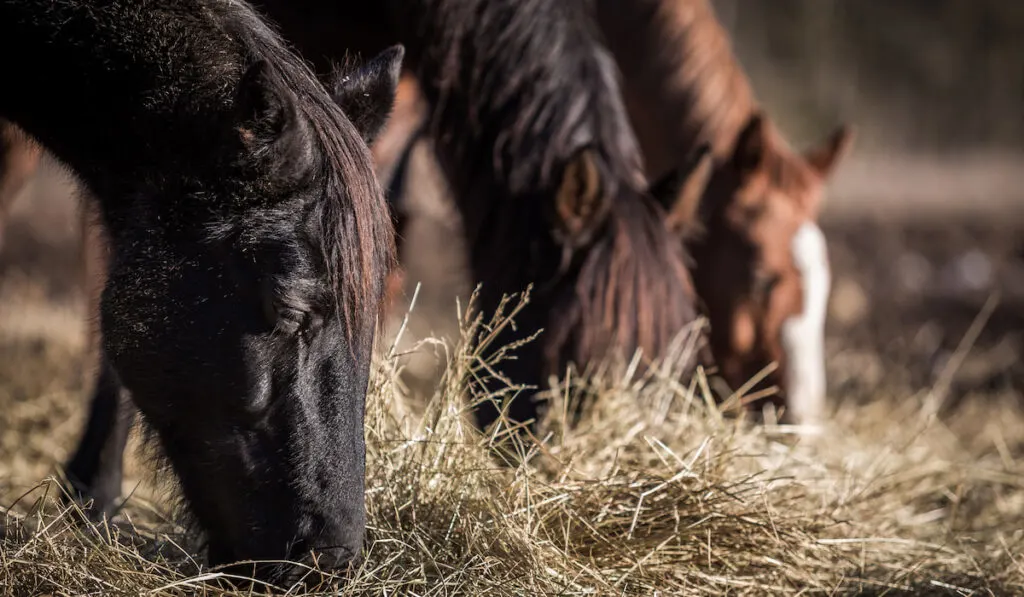
Precautions Against Overfeeding
It is very possible to overfeed a horse. This is especially true in the case of grain which is highly palatable but, a horse can also be overfed forage.
You will want to be sure to evaluate each horse’s nutritional requirements as an individual. What you don’t want is to feed them more than is recommended for their weight and composition during a single feeding.
Overfeeding grain especially can cause your horse to develop an impaction in their intestines, which can result in colic. Chronic overfeeding can lead to obesity and laminitis, a hoof disease that can cause a horse to be lame and unable to walk.
Henneke Body Condition Score
The Henneke body condition score is typically used to determine whether a horse is underweight or overweight and the degree of each.
While there are numerous articles on this method, I think the easiest way for someone to learn it is by watching the scoring process.
This is an excellent video that shows the body condition scoring process and the scores of a variety of different horses.
If your horse falls below the average weight range, discover effective strategies on how to put weight on a horse.
Monitoring Weight
Regularly monitoring the weight of your horse can help to ensure that they are not losing or gaining too much weight without you noticing.
Most horse owners see their horses regularly and the small, day to day weight gain or loss may not be easily apparent. More than likely, you may notice one day that your horse has suddenly gotten fat or is looking skinny. By the time that happens, it is possible that several hundred pounds have already been gained or lost.
If you monitor your horse’s weight on a monthly basis, you are more likely to notice a big change. A simple horse weight log can tell you how close your horse is to last month’s measurements and whether those measurements have been increasing or decreasing over time.
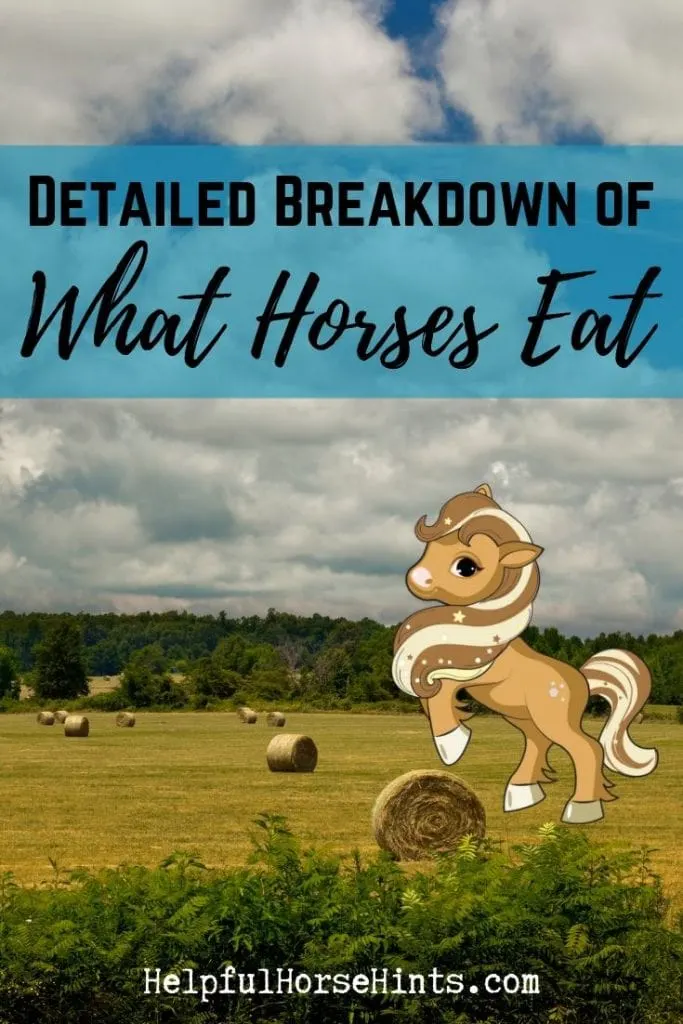
Special Diets
Some horses have genetic diseases or metabolic conditions that require a specialized diet. Additionally, just as with humans, horses can develop allergies to certain foods.
HYPP
Research has shown that diet can make a difference in HYPP positive horses. HYPP attacks in horses happen when potassium levels rise. The disease affects the release of the counterbalance, sodium.
As a precautionary measure, to aid in the prevention of HYPP attacks, positive horses should be fed a diet that is limited in potassium. The problem, there, is that potassium is naturally occurring in most horse forages.
In fact, Alfalfa hay is usually quite high in potassium but grass hays have it as well. On the upside, hay and pasture can be tested for potassium levels. With that information on hand, an equine nutritionist can help formulate a low-potassium ration for your HYPP affected horse. (source)
Insulin Resistant Horses
Equine Metabolic Syndrom (EMS), commonly called insulin resistance, is a disease that affects some horses.
Researchers don’t know what causes insulin resistance but, age is a factor. Horses with cushings also commonly have this issue although even young horses and ponies can show symptoms. (source)
The best treatment AND prevention for insulin resistance in horses is to feed a well-balanced diet and make sure your horse is getting enough exercise to prevent obesity. (source)
Dangerous or Toxic Foods
While most fruits and veggies are safe for your horse, there are many foods that are dangerous for horses. Understandably, meats, chocolate and caffeine are not safe to give your horse. Some vegetables like potatoes and tomatoes are typically avoided as horse feeds as well.
Dog foods and cattle feed are both especially dangerous for horses. There are certain additives in foods for ruminant animals like cows that horses cannot tolerate. These can sometimes be fatal for horses.
Not all naturally occurring plants are safe. There are many types of plants that if fed, or in the case of fescue, if fed at the wrong time, could cause your horse to become sick or die.
Typically, if you purchase your hay and grains from a reputable feed company and use only feeds formulated for horses, you should not have anything to worry about.
Final Thoughts
While there are some horses out there that are just easy keepers, most horses need to stick to a regular feeding program to maintain a healthy digestive system. Start with good quality forage and add in any vitamins or minerals necessary for your area. It may seem like a lot to learn, but once you have a good program in place, all you have to do is just stick with it.
Related Posts
- Considerations for Feeding Your Horse Once A Day
- Squash and Zucchini For Your Horse (w/ treat recipe)
- Beet Pulp for Your Horses: Should You Feed Wet or Dry?

